Hanover Bald Eagle Blog # 19 - 2022
In partnership with Pennsylvania Game Commission and Comcast Business .
The eaglets are inching closer and closer to their first flight. Prior to leaping from the nest, they must strengthen their flight muscles and practice coordination, hence the hopping behavior we’ve been seeing this week, called branching.
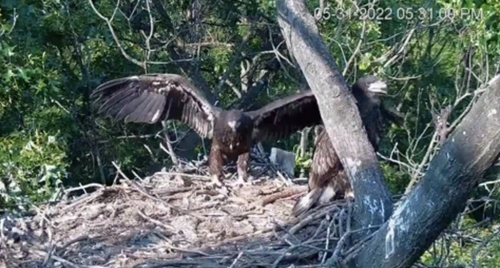
Flight is one of the most enviable gifts that exists within the animal kingdom, and although humans have done an impressive job at recreating the experience via technological advances, nothing quite compares to the natural grace of a bald eagle soaring through the air. To achieve aerial prowess, all flighted birds have evolved a basic skeletal structure that makes flight possible.
Skeletal adaptations such as light bones, fused thoracic vertebrae, a flexible neck, a keel-shaped sternum, and a wishbone are a few important pieces to the puzzle of avian flight. Without these skeletal superpowers, birds could not fly, regardless of whether or not they had feathers.
Most birds possess a unique system of struts within their bones that allow for airspace, which lightens the overall weight of each bone and simultaneously preserves their structural integrity. Additionally, the fusion of several key bones adds rigidity and lightness to bird skeletons, without compromising the sturdiness necessary while they combat winds, weather, and other forces of nature inherent to sky travel. Some airplane wings have an almost identical composition called the Warren truss.
Birds are also the only vertebrates with a fused collarbone, known to many of us as the wishbone (the coveted prize at the end of a turkey dinner). During flight, the unique shape of the wishbone serves as an anchor for powerful flight muscles, while also protecting the chest cavity during the upstroke.
The anatomy of a bird wing shows a surprising likeness to the human arm, as compared below. Birds too possess a humerus, unla, carpals, and modified digits!
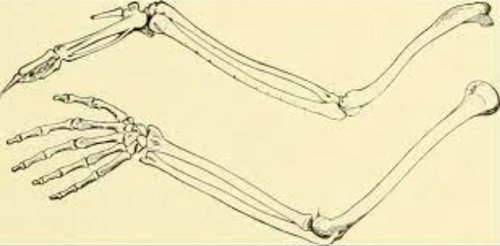
The two most important muscles for flight are called the supracoracoideus, which raises the wings, and the pectoralis, responsible for the downward power stroke. Without a bird’s complex skeletal structure, the attachment of these muscles would not be possible. The human sternum does not have enough surface area to support muscles large enough to power human flight. Ostriches, too, lack a keel, and their tiny wings alone cannot support their weight. Therefore, they remain terrestrial. The vertical keel of flighted birds substantially increases the surface area of the sternum, which anchors the upstroke and downstroke muscles, therefore allowing birds to raise and lower their wings. Essentially, birds carry around an ingenious pulley system. The size of a bird’s keel reflects the size of the bird — larger keel means larger bird. Bald eagles therefore have a larger keel than many other species.
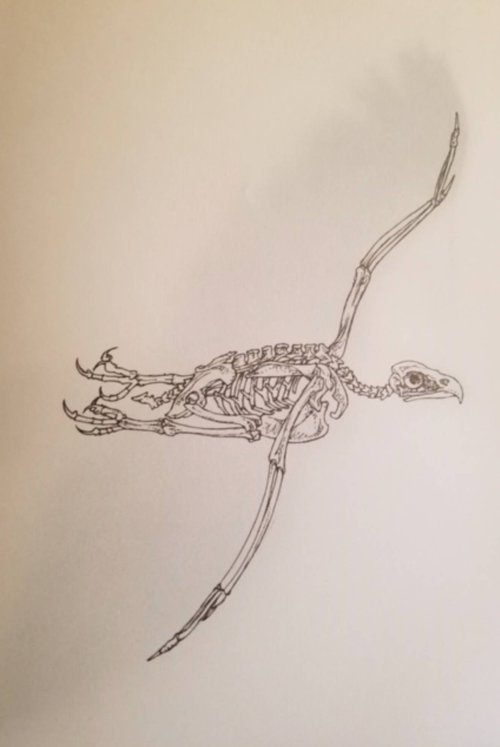
Drawing of bald eagle skeleton. (Source: Dave Hughes).
Although flying birds share a common skeletal framework, they differ in other flight-related features, such as the ratio of red to white muscles, and the type of wings they have. Even between raptor species wing types differ notably.
Red muscle fibers are responsible for sustained flight over long periods of time. White muscle fibers are used in explosive movements over short durations. Just as we utilize different muscles for sprinting versus long distance running, soaring birds like eagles possess a higher ratio of red muscle fibers in their breast muscles than, say, grouse, which engage in short bursts of flight.
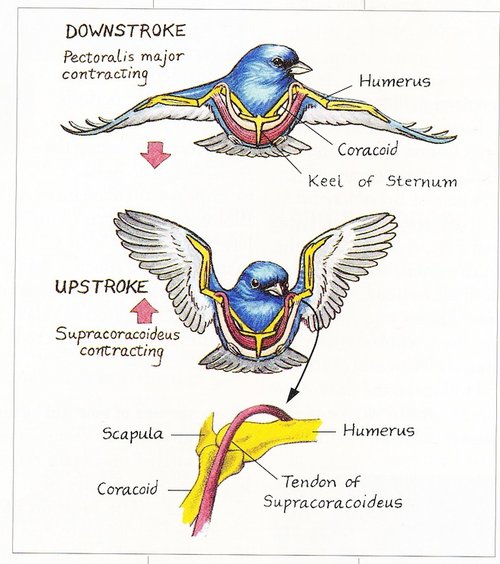
Muscles involved in the upstroke and downstroke during flight are colored in red. (Source: Denise Takahashi).
Eagles have large, broad wings that allow them to easily catch thermals and glide for long distances. Falcons, on the other hand, have pointed wings that aid them in high speed chases as they pursue other birds. Sharp-shinned hawks and cooper’s hawks are forest hunters, so they have aerodynamic wings that help them succeed in their wild maneuvers as they zip in between trees. To each their own!
During these final weeks before fledging, the eaglets will increase their activity levels inside the nest. Typically, male eaglets show higher levels of restlessness than females, and fledge sooner (this does not mean that the first eaglet to leave the nest is undoubtedly male). The eaglets are now 10 weeks old, and fledging typically occurs between 8 and 14 weeks from hatch date. Any day now, we could witness the first flight of these beloved youngsters!
Fun Facts
- Intriguingly, the presence of a keel has become a helpful indicator for paleontologists as to whether or not fossils belong to a flighted or flightless bird.
- One in seven eaglets fledge early, sometimes spending a few days on the ground before their first flight.
SOURCES
Gerrard, Jon M. & Bortolotti, Gary R. (1988). The Bald Eagle: Haunts and Habits of a Wilderness Monarch. Smithsonian Institution.
Greij, Eldon. (2019, January 8). The Amazing Muscles and Bones that Make Birds Fly. https://www.birdwatchingdaily.com/news/science/the-amazing-muscles-and-bones-that-make-birds-fly/
Fromme, Alison. (2014, May). Why Fly Flightless Bird Mystery Solved, Say Evolutionary Scientists. National Geographic.
Page, Jake & Morton, Eugene S. (1989). Lords of the Air. Crown Publishers New York New York.
Wilson, Herb. (2011, January 13). Bird Muscles. https://web.colby.edu/mainebirds/2011/01/13/bird-muscles/
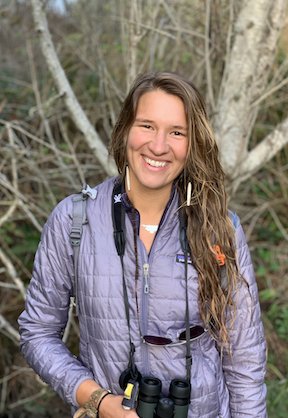
Raptor Ecology Specialist - Zoey Greenberg
RETURN TO HANOVER BALD EAGLE BLOGS
WATCH THE HANOVER BALD EAGLE LIVE CAMS
For over 20 years, HDOnTap has provided live streaming solutions to resorts, amusement parks, wildlife refuges and more. In addition to maintaining a network of over 400 live webcams, HDOnTap specializes in design and installation of remote, off-grid and otherwise challenging live streaming solutions. Contact press@hdontap.com for all media needs, including images and recordings.